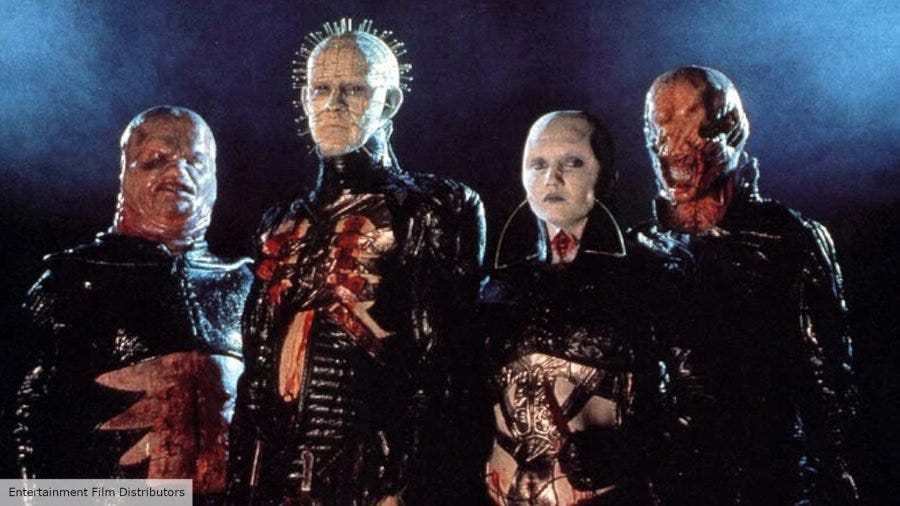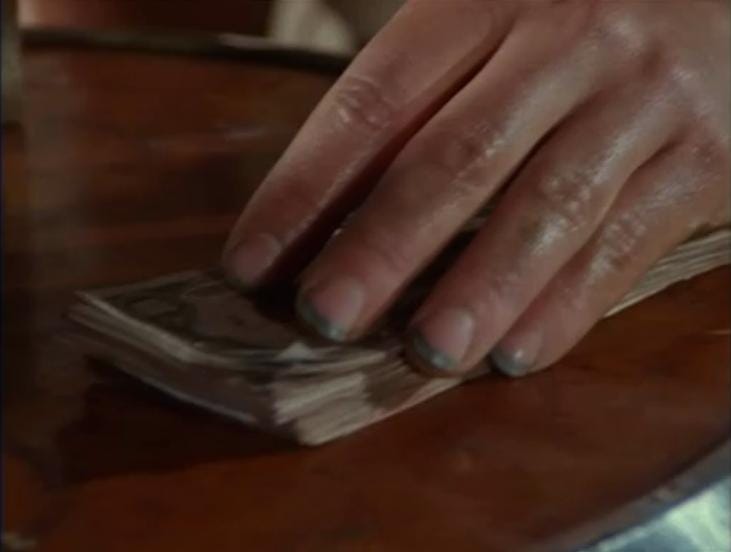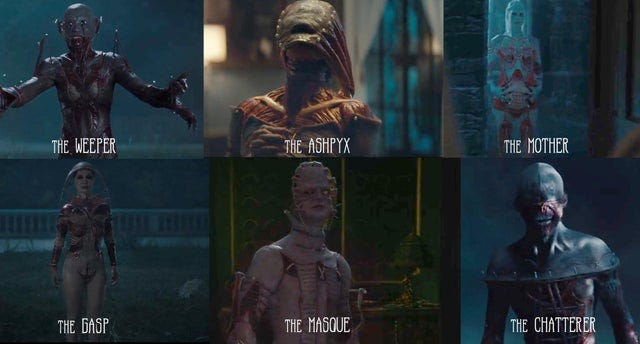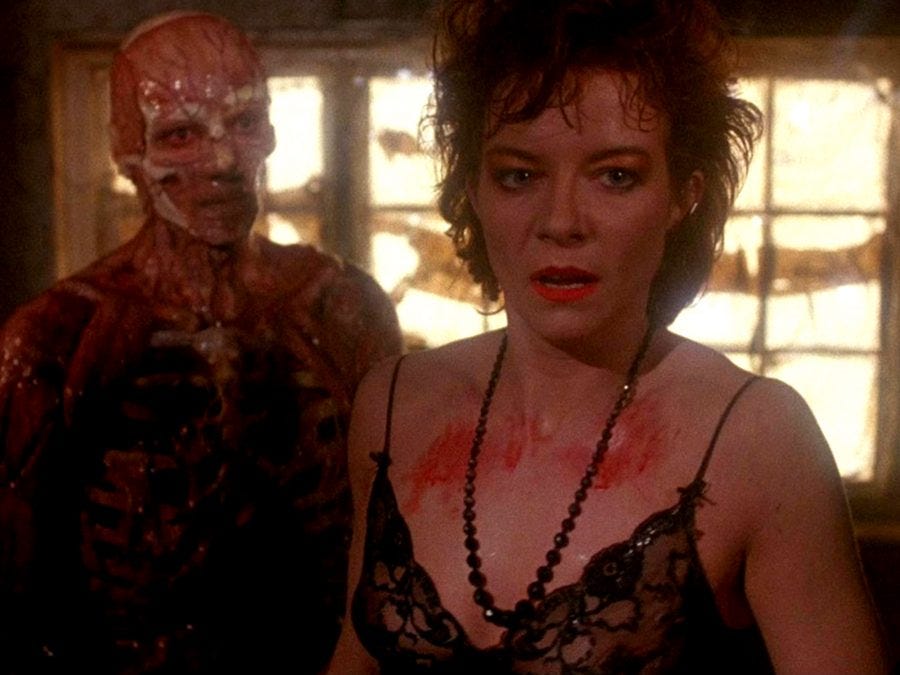The infamous Hays Code enjoyed its reign of terror from roughly 1934 to roughly 1968. The Code laid out morality guidelines for movies to follow, lest they be deemed too inappropriate. It’s an interesting example of self-censorship: the Code came from Hollywood’s attempts to regulate themselves before the government did. It truly took off because enough powerful people were loud enough in their fear that Hollywood was a cesspool of immorality (accurate), and that movies would corrupt susceptible-minded folks and bring about the downfall of decent society. And because we’re obsessed with repeating the past, it feels to me like we’re headed back in a Hays Code direction.
The stickiest example in my mind right now is the new Hellraiser movie, especially when you hang it up next to the 1987 original. Spoilers for both movies absolutely abound from here on out. You were warned.
Creator Clive Barker pulled from his own passions—including S&M clubs, which inspire the Cenobites’ leather fetishwear—and fears, especially the plague that was consuming so many queer men like Barker. Leaders talked about and treated AIDS as a disease born of sin, punishment for unnatural and excessive appetites. Death by excess seemed inevitable. Barker takes all of that sticky, complicated mess and stitches it throughout his gothic fairytale about pain, pleasure, and transcendence. Here’s Google’s plot summary:
Sexual deviant [editor’s note - lmao] Frank inadvertently opens a portal to hell when he tinkers with a box he bought while abroad. The act unleashes gruesome beings called Cenobites, who tear Frank's body apart. When Frank's brother and his wife, Julia, move into Frank's old house, they accidentally bring what is left of Frank back to life. Frank then convinces Julia, his one-time lover, to lure men back to the house so he can use their blood to reconstruct himself.
The practical effects in 1987’s original are my favourite kind - extremely gooey and fleshy. Even if they don’t always look ~realistic~ (what an annoying word when you’re talking about art), they look real, as in physical, believable. You could reach out and touch these bodies and their wounds, and that thought alone is terrifying. The Cenobites’ various wounds bleed—their pain and its attendant pleasure are eternally fresh. The creatures are both otherworldly and somehow very tangible in this world.
1987’s protagonist, Julia, is also one of the villains. (People will tell you Kristy is the protagonist; she is the hero, but Julia gets more screen time, more backstory, more personality, and more action.) Julia’s desires—for sex, for passion, for the man who liberated her from a stifling existence—drive every decision she makes. She chooses to cheat on her husband with his brother. And when she find her lover’s completely flayed but still living body in the attic, she chooses to help him. Specifically, she chooses to kill for him. She chooses pleasure that makes her feel alive over a life with the impossibly boring man who blames her for being attractive to other men, and who faints at the sight of blood.
For his part, big bad Frank makes a lot of knowingly destructive choices as well. The movie opens with the following exchange:
Merchant: What’s your pleasure, Mr. Cotton?
Frank and the grimiest fingernails you’ve ever seen: The box.
He pursued a sensation he had never felt before, and got “an experience beyond limits. Pain and pleasure, indivisible.” His appetites are what bring danger into everyone’s world. Desire throbs through the entire movie.
Now, the Google summary of the 2022 Hellraiser:
A young woman must confront the sadistic, supernatural forces behind an enigmatic puzzle box responsible for her brother's disappearance.
2022’s Hellraiser does away with the heavy musing on pleasure and pain, because it effectively does away with pleasure as a legitimate possibility. The one character who seeks pleasure is the villain, Voight, who works primarily through intermediaries. He sends an employee to get the puzzle box, and has her send him victims to unlock each of the box’s configurations. We ultimately learn that the Cenobites didn’t give him what he wanted — “I sought pleasure, and all they had to give was pain.” But Voight never made himself vulnerable in his pursuit, never opened himself up to the risk inherent in opening the box in the first place. He tried to get all pleasure and no pain, and the Cenobites gave him the reversal he deserved.
Continuing the simplification trend, the makeup effects in 2022 are much sleeker, more intricate and beautiful — impressive. Instead of pulling away out of revulsion, and then letting myself peek again, with every new Cenobite I leaned in to appreciate the really fine handiwork. They’re no longer wearing leather, which is both very human and very sexual; now their bodies are bio-mechanical, more like Xenomorphs than people. The idea that Cenobites were ever earthly seems intentionally distant.
Our 2022 protagonist, Riley, is frustratingly passive. Unlike Julia, she makes very few decisions for herself throughout the movie. That’s both her arc—her final bit of dialogue is announcing that she “made a decision” —and a symptom of the morally puritanical age we’re in right now. After a long era of the morally gray anti-hero, the culture has swung back to the black-and-white morality of the Hays Code era. Audiences want their heroes in white hats and their villains in black.
Some of the most relevant edicts from the Hays Code are about sex and villainy. First, “sexual relations outside marriage, which were forbidden to be portrayed as attractive or beautiful, were to be presented in a way that would not arouse passion or make them seem permissible.” In 2022’s Hellraiser, sex and the transcendence that can come from it are no longer motivators. Riley has sex as a means to escape her emotions, especially her grief. There’s nothing sexy about the two sex scenes, just sad. This fits well in our currently sexless pop culture landscape, where Chloé Zhao had to explain why she included a love scene in her latest Marvel movie, and Harry Styles confidently claimed that his upcoming movie will bring the tenderness missing from “so much of gay sex on film.” There’s also an increasingly vocal corner of the internet that decries any sex scene as gratuitous and exploitative, a sentiment that feels familiar in its reactionary regression. Movies are starved right now for any kind of erotic spark.
Second, “all criminal action had to be punished, and neither the crime nor the criminal could elicit sympathy from the audience, or the audience must at least be aware that such behavior is wrong…throughout, the audience feels sure that evil is wrong, and good is right.” The 2022 plot generally keeps Riley at least one step removed from decisions that hurt and kill the people around her. Either her addiction, her treacherous boyfriend, or the wannabe mastermind Voight are to blame. Even finding the puzzle box at all is a set-up. Once she finally makes a choice, it’s essentially to opt out of the Cenobites’ dark plot altogether, tying a neat bow on her addiction allegory. We can safely approve of her as a hero, because she doesn’t actively do anything evil. We don’t have to risk any moral uncertainty, so nothing can feel transgressive.
I’m almost exactly the same age as the original, and I think I’m officially too old to be scared or even moved by the remake. My tastes are chained to the pulpy body horror of the ‘80s. The core of body horror is the knowledge that our bodies are vulnerable and at some point will betray us. On some level, Julia knows that choosing Frank means choosing pain and betrayal just as much as pleasure. That’s the kind of complication I can rock with. In the face of growing prudishness, I choose the mess and sensation of the ‘80s over the order and sanitization of the ‘20s.








